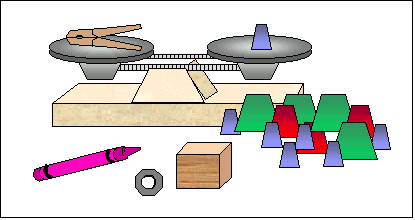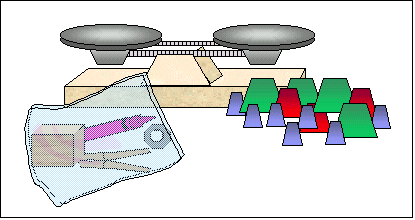|
Contributed by: Illinois Science Teachers Association (ILS)
Description:
Students perform routine laboratory procedures and report results.
The task assesses primary students' ability to perform measurement
and reporting skills.
This task is designed to take students approximately 8 minutes
to complete.
Overall Task Content Area:
- Physical Science
Specific Knowledge Areas:
- Properties of Objects and Materials
Performance Expectations:
- using equipment
- gathering, organizing, and representing data
National Science Education Standards:
4 A SI 1: Abilities necessary to do scientific inquiry:
Grades K-4
1.3 Employ simple equipment and tools to gather data and
extend the senses. In early years, students develop simple skills,
such as how to observe, measure, cut, connect, switch, turn on and
off, pour, hold, tie, and hook. Beginning with simple instruments,
students can use rulers to measure the length, height, and depth
of objects and materials; thermometers to measure temperature; watches
to measure time; beam balances and spring scales to measure weight
and force; magnifiers to observe objects and organisms; and microscopes
to observe the finer details of plants, animals, rocks, and other
materials. Children also develop skills in the use of computers
and calculators for conducting investigations.
4 B PS 1: Properties of Objects and Materials: Grades
K-4
1.1 Objects have many observable properties, including size,
weight, shape, color, temperature, and the ability to react with
other substances. Those properties can be measured using tools,
such as rulers, balances and thermometers.
(Use the "hot" link on the PALS home page
to check the full text of related National Science Education Standards,
if desired.)
National Council of Teachers of Mathematics:
DAP1: Formulate questions that can
be addressed with data and collect, organize, and display relevant
data to answer them:
Grades pre K-5 e. collect data using observations,
surveys, and experiments
Grades pre K-5 f. represent data using tables
and graphs such as line plots, bar graphs, and line graphs
MEAS1: Understand measurable attributes of objects and
the units, systems, and processes of measurement:
Grades pre K-5 a. understand such attributes as length, area,
weight, volume, and size of angle and select the appropriate type
of unit for measuring each attribute
Grades pre K-5 b. compare and order objects according to these
(length, volume, weight, area, and time) attributes
Grades pre K-5 c. understand how to measure
using nonstandard and standard units
REP1: Create and use representations to organize, record,
and communicate mathematical ideas:
Grades pre K-5
General Instructions to the Teacher:
This task is designed to take students approximately 8 minutes
to complete.
Students will be working individually during this exercise.
Students should be ready to work as soon as the period begins.
The materials should be set out at each lab station, if possible.
A central supply area, if needed, should be easily accessible. All
supplies should be clearly labeled.
Materials for "Measurement: Using the balance":
The teacher will need:
- pen
- ruler
- cardboard
- cups
- Graduated cylinder
- scissors
- plastic bags
At this station students should have:
- Double-pan balance
- Plastic bag containing:
- crayon
- clothespin
- washer
- wooden block
- 25 colored gram cubes
Advance Preparation:
- Verify mass of each object and record these mass measurements
on the scoring sheet.
- Place all materials on the top of the table; leave objects in
sealed bag.
Safety:
- Be careful.
- Teachers and students should always exercise appropriate safety
precautions and utilize appropriate laboratory safety procedures
and equipment when working on science performance tasks.
Extensions/modifications:
- Measurement: Using the balance is one part of a five part assessment
that was administered in Illinois. The other 4 stations are "Classification,"
"Measurement: Length, volume, and temperature," "Mystery Boxes,"
and "Magnetic Testing."
- To expand and target the specific NCTM standard(s) to be measured,
ask students to select and use benchmarks to estimate measurement.
- Rubric language should be expanded and targeted to the specific
NCTM standard(s) to be measured.
Advanced Preparation Set Up:
Record weight of each item.
 |
Organize student work station.
 |
|



